The ideal length of a blog post is one that people read. That much is obvious. But let’s face it: You’re writing for your audience, but you’re hoping for search engine optimization. That’s why, when people talk about ideal content length, they’re often considering it in the context of SEO.
The word count on your posts matters for SEO because of the way Google ranks its search results pages. Longer content creation typically ranks higher in a Google search because of its connection to the RankBrain algorithm:
RankBrain uses machine learning to determine user satisfaction. When users stay longer, and keep clicking through, your website wins. Longer content = more dwell time and higher user satisfaction.
Of course, it’s a little more complex than that. The quality of your content matters just as much as the length. But when you get both? You’re well on your way to winning the SEO game. So let’s dig into what that ideal length actually means.
- What variables affect your ideal blog post length?
- Statistics on content length
- Ideal paragraph length
- Pros and cons of short-form posts
- Pros and cons of long-form content
- Ideal length for different types of posts
- The right length for your marketing strategy

How Long Should a Blog Post Be? The Variables of the Ideal Blog Post Length
Generally speaking, and taking quality out of the equation, long-form content performs better for SEO than short posts. That’s because it has more staying power, can answer a searcher’s query more completely, and results in longer dwell times. Exactly how long that blog post should be, of course, depends on a few things:
- What are you writing about? The subject matter plays a major role. Listicles, for examples, have a different average length than long-form content.
- What are your goals? There are scenarios in which a high quantity of shorter posts actually benefit your content marketing more than less frequent but longer blog posts.
- How much time do you have? On average, it takes more than three hours to write high-quality blog content that receives plenty of backlinks. Do you have the time to invest in longer posts?
- Who is your target audience? A complex, 4,000+ word piece of content may not score high readability marks for audiences just looking for short, snackable articles.
- What are your target keywords? Your keyword research can help you orient your own length towards that of your closest competition on search engine results pages (SERPs).
As with so many other blogging and content marketing topics, there is no simple answer. Fortunately, we can break it down further for you!
What Do Statistics Say About the Ideal Content Length?
Why guess at an ideal length when you have quantitative studies on your side? To start, a 2013 study by Medium found that the optimal length of a web page article is 7 minutes, which comes out to just about 1,600 words:
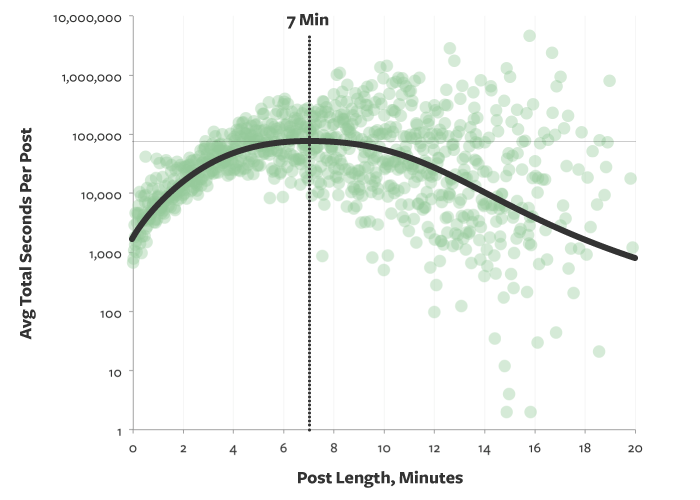
More recently, though, that length is creeping up. A 2020 survey of 1,279 bloggers by Orbit Media found that articles of 3,000 words or more are most likely to yield “strong results.” In that survey, posts over 1,500 words begin to perform above average:
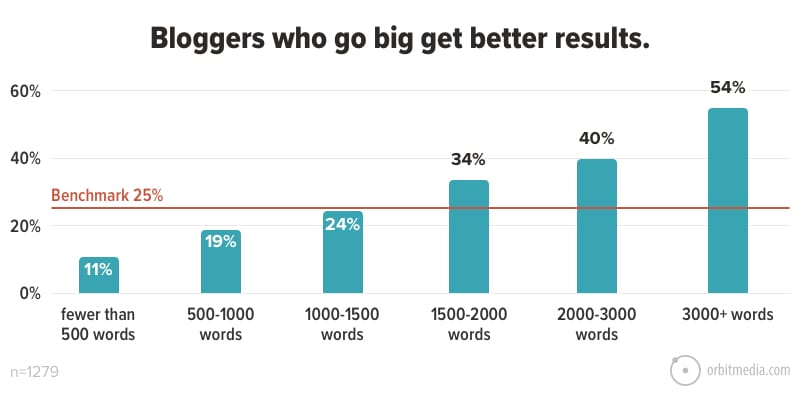
That trend towards longer blog posts is evident in other studies, as well. At the same time, remember that no piece of content exists in isolation; Neil Patel, breaking it down by industry, found that ideal length can range anywhere between 300 and 2,700 words.
The Average Length of a Post on Page 1
Let’s take a closer look at the typical length of the first page of Google results.
When CoSchedule analyzed search engine rankings in 2018, it found that every post ranked on the first page of Google was above 2,000 words. The average was close to 3,000 words.
Here’s why that average matters: 75% of users never click past the first page of Google. If you’re looking to compete, you need to stack up.
Content Word Count by Google Position
Averages, of course, can only tell you so much. Exactly how those word counts spread out across the top 10 search results is even more informative.
SerpIQ ran a study focused on just that topic. It charted the average word count of the top 10 results across a broad range of keywords:
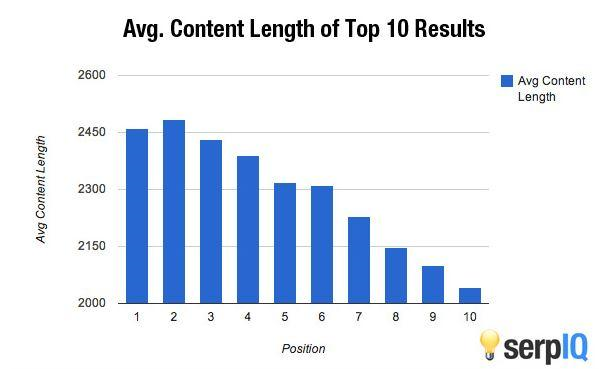
If you’re looking to optimize your content marketing for organic traffic, there’s your guide. The top four results all average at or above 2,400 words. The decline is linear after that, but even the 10th search result still tends to be a 2,000+ word blog post.
How Content Length Relates to Social Media Shares and Attention
Organic traffic, of course, might not be your only goal. Maybe you’re looking to build your social media presence? Have no fear: Plenty of studies have examined that exact topic, as well.
When QuickSprout ran a study on social shares by content length, they found that articles above 1,500 words received 22% more shares on Facebook and a stunning 68% more shares on Twitter:

We can get more extreme, too. In CoSchedule’s study on content length, the top five pieces of content were all above 3,000 words, with the top performer clocking in at 5,000:
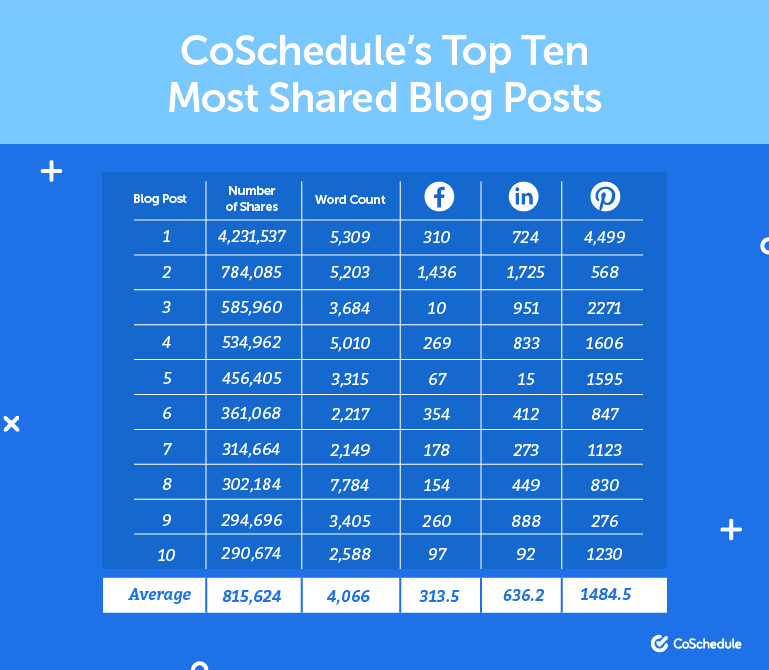
Sure, your audience will tweet about your shorter content. But if you really want to get their attention on social media, that long-form content can help you break through.
What is the Ideal Length of a Paragraph for SEO?
The length of your post isn’t the only thing that affects readability and SEO. Buffer puts the ideal length of an online paragraph between 40 and 55 characters. That’s just enough to get crucial information across without boring your audience. Want an idea of how much that is? This paragraph is 55 characters long… now.
At the same time, that number changes depending on how your website is set up. Our own experience has taught us that you should never have more than 5 lines in an online paragraph. If your site is set up so that the main text area makes up more than 60% of the screen on a desktop, reduce that number to 4 lines.
Of course, the nuances of quality content matter here too. If you need to go a few words beyond that limit to make the paragraph more insightful, go for it.

Pros and Cons of Short-Form Blog Posts
All we’ve given you so far are ranges. That’s because in reality, it comes down to making the right content length choice for your specific piece of content. Going for shorter blog posts? Here are some pros and cons to consider:
| Benefits of Short Blog Posts | Drawbacks of Short Blog Posts |
| Easier to start a regular content calendar. | Will receive fewer social shares than longer posts. |
| Higher quantity of posts allows for a wider range of topics. | Will receive lower search rankings than longer content. |
| Wider topic ranges lead to more comprehensive keyword coverage. | Thinner content without the ability to add much detail or context. |
| More frequently updated blogs receive higher Google ‘freshness’ rankings | Not enough space to focus on multiple keywords or keyword variations. |
Another benefit of shorter posts? Short-form written content lends itself to inserting infographics, which can simplify complex topics into a more visual and straightforward overview.
Pros and Cons of Long-Form Content
Let’s compare the above with longer-form blog posts. Having read this far, you might think they’re the nonplusultra and ultimate best choice. Well… maybe. We’ll let you judge for yourself:
| Benefits of Longer Blog Posts | Drawbacks of Longer Blog Posts |
| Increase the time your audience spends on your page. | Take significantly longer to write |
| Result in more social shares. | The ‘quality barrier’ goes up significantly as expectations increase. |
| Lead to higher Google rankings. | Higher risk of ‘fluff’ just to make the desired word count. |
| Get more backlinks to your site. |
Another consideration: The longer the post, the more you need to consider readability. Break it down with plenty of subheadings, bullet points, and graphics. The more skimmable, the better, as it allows you to reach those with less time on their hands.
How Many Words Should Different Types of Blog Posts Be?
In your quest for the perfect blog post, you might be looking to write a simple how-to. Or, you may have a pillar page on your plate. It’s worth remembering:
There is no single ideal content length. The type of content matters at least as much as general best practices when it comes to counting those words.
Guess what? We’ve got you covered there as well. Here’s what you need to know.
The Ideal Length of Pillar Pages

Aim for 4,000 words when you write your pillar page. That’s based on research from HubSpot, which found that the median length of its best-performing pillar pages was 4,048 words.
That’s quite a lot, and it makes sense if you think about it. A pillar page is by necessity longer than the average blog post. After all, it’s supposed to be a comprehensive overview of an entire topic that links out to deep dives of its nuances.
Keep in mind that a page that long requires extra attention to make sure it keeps your readers’ attention. Your framework is crucial here, with a logical flow from the introduction all the way through the conclusion. You might even want to consider adding a table of contents, along with plenty of block quotes and bullet points throughout the text.
The Ideal Length of Listicles
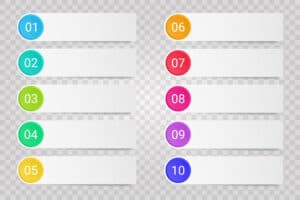
When writing a listicle, aim for around 2,400 words. That number probably sounds familiar for a reason; as it turns out, listicles are the single most common type of blog post on the first page of Google results.
There’s a psychological reason for that. According to a 2014 scientific study on the subject,
“The top-ten effect that we demonstrate in these studies is based on the mental tendencies to use categories and to exaggerate the differences between them. These tendencies are part of the natural human readiness to perceive the world in terms of discrete things.”
We like to categorize things, and listicles help us do just that. At the same time, our short attention span makes us want to scan things quickly, and listicles are the ideal scannable content. A perfect match for your next blog post – as long as it hits that target length.
The Ideal Length of ‘How-to’ Blogs

How do you build your perfect daily routine? How do you powerwash your driveway? How-to posts ensure lasting readability and are often evergreen. The ideal length of a How-to blog is about 1,700 words, but it can vary drastically.
That’s because the perfect number of words depends entirely on the subject matter. A simple explanation on how to use special characters in your keyword probably won’t need 2,000 words. That comprehensive guide on building a WordPress website from scratch, though? You’re lucky if you clock in below 5,000 words.
Clarity is the ultimate key for this type of content. Avoid fluff at all times, and add plenty of section headers to distinguish the different steps. The lower the reading level (a tool like Yoast can help you measure that), the more likely your audience will be to read it.
The Ideal Length of ‘What-is’ Blogs

When you’re writing a post that explains a ‘what’ question, aim for about 1,400 words. Since this type of content is less actionable than a guide, your paragraphs will typically be shorter, more fact-based, and less expansive. You don’t have to explain how to use a chainsaw; you just need to say what it is.
Encyclopedias everywhere owe their continued relevance to ‘What-is’ content. You’ll also find plenty of Wikipedia articles competing for the first page of Google results.
When you write your own, you can take one of two approaches:
- Write a short post that simply focuses on the definition and basic concept.
- Write a longer post that starts with the basic concept but goes into depth on its nuances.
It all differs based on the specific topic but in most cases, the first option likely has a better payoff. Your audience comes for the definition, and will likely leave as soon as they’re done reading it. As long as you can provide that quick answer or explanation—optimized for the right keyword, of course—you’re in good shape.
Finding the Best Blog Post Length For Your Marketing Strategy
Let’s make it simple. These are your core takeaways when thinking about ideal content length:
- Your perfect content length depends on your audience, marketing goals, topic, and target keywords.
- Optimal length is getting longer, from 1,600 words in 2016 to 3,000+ words in 2020.
- There’s a pretty consistent linear relationship between length and placement on Google’s first page, from 2,400+ words for the #1 placement to just over 2,000 words for #10.
- On social media, content above 1,500 words receives the most shares and interactions.
- The ideal paragraph size for SEO is between 40 and 55 words.
- Pillar pages should be around 4,000 words long.
- Listicles clock in around a 2,400 word average.
- How-to posts average about 1,700 words, but that number can fluctuate wildly. depending on how complex and comprehensive your tutorial needs to be.
- What-is posts are typically shortest at 1,400 words because you only need to explain the concept in its basic terms.

And then, of course, you have to keep in mind that it takes more than a single piece of content to achieve results. Ultimately, your strategy should include a mix of all of the above—and a consistent publishing cadence—to build your SEO value over time.
Such is the complexity of modern online content creation. Fortunately, you’re not in it alone. In fact, we happen to know a few writers who can help you create that content! (3,000 of them, to be exact.)
If you understand the value of content but don’t know where to start or simply don’t have the time to write it yourself, let’s talk. Verblio’s content writing services are designed to make content creation simple and painless, allowing you to get the quality pieces you want at the scale you need for an effective SEO strategy.



